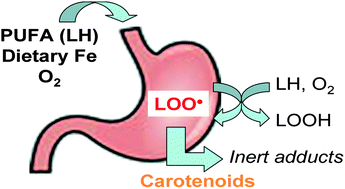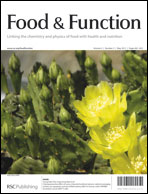Newly identified spore-forming pigmented marine bacteria, Bacillus indicus HU36 and Bacillus firmus GB1, are sources of carotenoids (mainly 15 yellow and orange pigments and 13 pink pigments, respectively) with original structures. These bacterial carotenoids were evaluated for their ability to inhibit the iron-induced peroxidation of linoleic acid micelles, or sunflower oil-in-water emulsions, in comparison with β-carotene, lycopene and astaxanthin. Lipid peroxidation was carried out in acidic conditions and initiated by dietary heme or non-heme iron (metmyoglobin or FeII, respectively) so as to simply simulate the postprandial gastric medium, a possible site for dietary oxidative stress. Lipid hydroperoxide formation and carotenoid consumption were followed by UV-vis spectroscopy and appropriate indicators of the antioxidant activity were estimated in each model. The bacterial carotenoids were found to be better inhibitors of heme-induced lipid peroxidation than the reference carotenoids as a likely consequence of their location closer to the interface in micelles and lipid droplets. However, this trend was not confirmed in lipid peroxidation induced by non-heme iron, possibly because of the redox recycling of FeII by carotenoids. The quantitative kinetic analysis of the peroxidation curves suggests that the carotenoids mainly inhibit the propagation phase of lipid peroxidation by direct scavenging of the lipid peroxyl radicals, in agreement with independent experiments showing that carotenoids are unable to reduce the one-electron oxidized form of metmyoglobin (ferrylmyoglobin), a model of initiating species in heme-induced lipid peroxidation. Overall, carotenoids from Bacillus indicus HU36 and Bacillus firmus GB1 were found to be interesting antioxidants to fight postprandial oxidative stress in the stomach.

You have access to this article
 Please wait while we load your content...
Something went wrong. Try again?
Please wait while we load your content...
Something went wrong. Try again?


 Please wait while we load your content...
Please wait while we load your content...